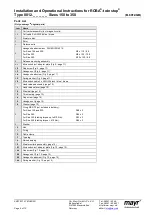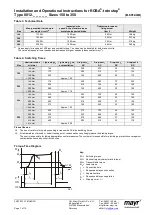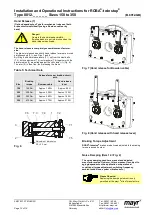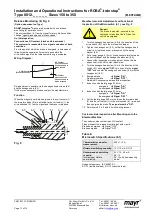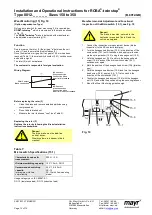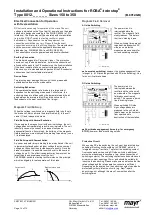
Installation and Operational Instructions for ROBA
®
-twinstop
®
Type 8012._ _ _ _ _ Sizes 150 to 350
(B.8012.GB)
05/07/2010 TK/HW/SU
Chr. Mayr GmbH + Co. KG
Tel.: 08341 / 804-0
Eichenstraße 1
Fax: 08341 / 804-421
D-87665 Mauerstetten
http://www.mayr.de
Page 15 of 15
Germany eMail:
info@mayr.de
Customer-side Brake Inspection (after Mounting
onto the Elevator Machine)
Individual air gap inspection
(Nominal air gap "a" and air gap "b" on both brake circuits
acc. Table 1 and Figs. 3 / 4).
Braking torque inspection:
Please compare the requested braking torque with the
torque stated on the Type Tag.
Release function inspection
(Battery operated to guarantee emergency escape for
passengers during a power failure).
Switching function inspection
Energised brake
Signal "ON" (NO contact)
De-energised brake
Signal "OFF" (NO contact)
Dual Circuit Brake Functional Inspection
The
ROBA
®
-twinstop
®
brake is equipped with a double safety
(redundant) brake system.
This means that, should one circuit fail, the braking effect is
maintained.
Danger!
Should the elevator begin to move after
release of one brake circuit or should it fail to
react to the braking procedure, the energised
coil must be switched off immediately!
The dual circuit function is not guaranteed.
Shut down the elevator, de-install and inspect the brake.
The individual circuit inspection is carried out by energising the
individual circuits with nominal voltage.
Inspection brake circuit 1:
1. Energise brake circuit 2.
2. Trigger an emergency STOP with brake circuit 1 and
inspect the stopping distance according to the elevator
regulations.
3. De-energise brake circuit 2.
Inspection brake circuit 2:
1. Energise brake circuit 1.
2. Trigger an emergency STOP with the brake circuit 2 and
inspect the stopping distance according to the elevator
regulations.
3. De-energise brake circuit 1.
Inspection both circuits:
Energise both braking circuits with nominal voltage.
Trigger an emergency STOP and inspect the stopping distance
according to the elevator regulations. The stopping distance
must be much shorter than the stopping distance for an
individual circuit.
Maintenance
ROBA
®
-twinstop
®
brakes are mainly maintenance-free. The
friction linings are robust and wear-resistant. This ensures a
particularly long service lifetime.
However, the friction linings are subject to functional wear on
frequent use of emergency STOP. Therefore, the following
inspections are to be carried out at regular inspection intervals:
Braking torque or retardation inspection
(individual brake circuits).
(TÜV interval)
Inspection of air gap braked
(both brake circuits)
(TÜV interval)
Inspection of toothing backlash, toothed hub on motor to
the rotor (3) or hub (10) to the rotor (3)
Max. permitted toothing backlash 0,5°.
(TÜV interva l)
To inspect the rotor (3) wear condition, please measure the
air gap "a" acc. Table 1 and Figs. 3 /4.
If the brake limit air gap has been reached (0,9 mm),
meaning that the friction linings are worn down, the rotor
(3) must be replaced.
Please follow the Installation section backwards to
dismantle the brake (page 9).
Disposal
Our electromagnetic brake components must be disposed of
separately as they consist of different materials. Please observe
the relevant authority regulations. Code numbers may vary
according to the dismantling process (metal, plastic and cable).
Electronic components
(Rectifier / ROBA
®
-switch / Microswitch):
Products which have not been dismantled can be disposed of
under the Code 160214 (mixed materials) or Components under
Code. No. 160216, or can be disposed of by a certified disposal
firm.
Brake bodies made of steel pads with coil / cable
and all other steel components:
Steel scrap
(Code No. 160117)
Aluminium components:
Non-ferrous metals (Code No. 160118)
Brake rotor (steel or aluminium pads with friction linings):
Brake linings
(Code No. 160112)
Seals, O-rings, V-seals, elastomers, terminal boxes (PVC):
Plastic
(Code No. 160119)
Malfunctions / Breakdowns:
Malfunctions
Possible Causes
Solutions
Brake does not release
Incorrect voltage on rectifier
Rectifier failure
Air gap too large (worn rotor)
Coil interruption
Apply correct voltage
Replace rectifier
Replace rotor
Replace brake
Release monitoring does not switch
Brake does not release
Defective microswitch
Solution as above
Replace the microswitch (manufacturer-
side)
Summary of Contents for E27 Series
Page 4: ...4 E27 Gearless Installation and maintenance 5323 en 2018 04 c...
Page 15: ......
Page 46: ...30 31 NOTES...
Page 109: ......
Page 110: ......
Page 111: ......





